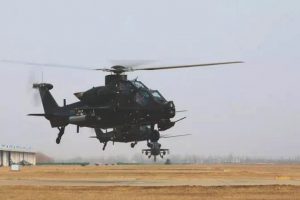Chinese state-owned media released images earlier this month showing the People’s Liberation Army (PLA) Changhe Aircraft Industries Corporation (CAIC) Zhishengji-10 (Z-10) attack helicopter fitted with new engine exhaust outlets that face upward instead of outward to reportedly reduce the rotorcraft’s frontal infrared signature.
The upgraded Z-10 was photographed during a military exercise with the PLA’s 80th Group Army on February 8, according to the Global Times. The images first appeared on the PLA’s WeChat account.
The Global Times in a February 17 report quoted Chinese military analysts as saying that the new configuration of the Z-10’s exhaust outlet will “inevitably increase drag force, raising the power requirement for the helicopter’s engines,” adding that the latest Z-10 variant “more than likely has greater engine power.”
Based on open-source intelligence, the Z-10 continues to be powered by WZ9 turboshaft engines. China, in cooperation with a European partner, has reportedly been working on a more powerful engine, the WZ-16. This engine, however, has not entered serial production yet, according to defense analysts. There is also no concrete indication that any Z-10s have been fitted with this more powerful engine.
Notably, the weak performance of WZ-9 turboshaft engines, which purportedly prevents the Z-10 from carrying its maximum weapons payload, including up to 16 HJ-10 anti-tank missiles, made the Pakistan Army decide against procuring the helicopter and opt for the T129 ATAK multirole attack helicopter instead in 2018. As I explained previously:
At the end, the T129 prevailed over the Z-10. China’s equivalent to the U.S. AH-64 Apache has so far failed to attract an international customer.
(…) [O]ne of the reasons for the lack of export success of the Z-10 could be the helicopter’s two under-powered WZ-9 turboshaft engines, which has been preventing the Z-10 from carrying its maximum payload during military operations. (PAAC deployed Z-10 helicopters during counterinsurgency operations since 2014.)
The tandem-seat Z-10 took to the sky for the first time in 2003 and has been supplied to at least five PLA aviation regiments. In 2016, the PLA announced that all of its ground force aviation units have been equipped with the Z-10.
The Z-10, co-designed by Kamov Design Bureau of Russia and the Chinese 602nd Aircraft Design Institute, is designed primarily for anti-tank warfare. It can be armed with AKD-9 or AKD-10 anti-tank missiles, rocket pods, and carries an under-nose turret for a 23-millimeter or 30-millimeter cannon. It also has a secondary air-to-air capability and can carry the TY-90 air-to-air missile.
In 2018, images emerged showing the Z-10 at a Chinese airfield featuring extra armor panels externally attached to the gunship. According to Chinese military experts, the additional armor panels are made of light material supposedly based on graphene due to the helicopter’s weak engine. “Chinese helicopters, including the Z-10, did not have extra armor because their engines could only lift a certain weight,” a Chinese military expert was quoted as saying by the Global Times on October 10, 2018.

































